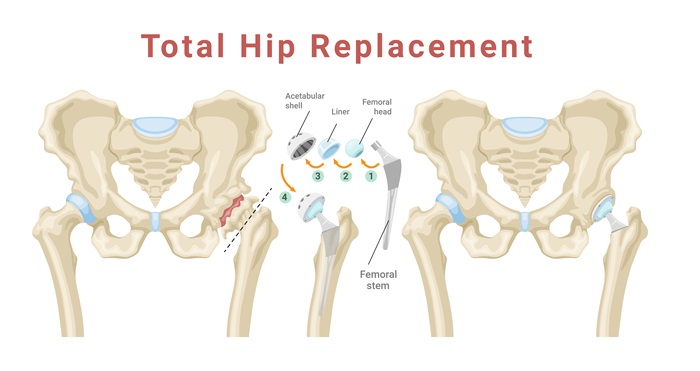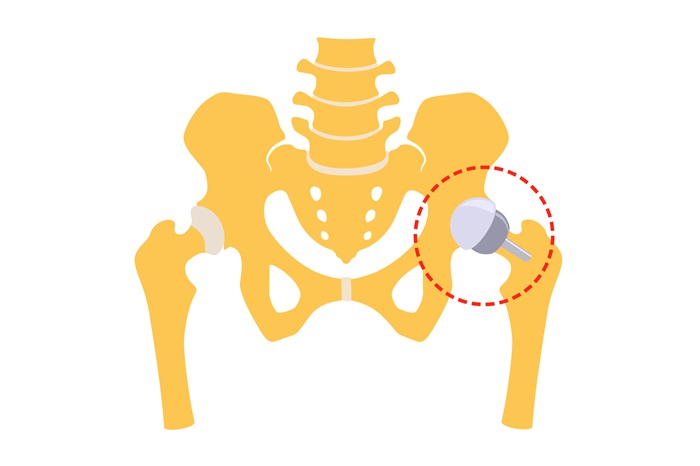Introduction
Hip replacement surgery, also known as hip arthroplasty, is a common procedure that helps relieve pain and improve mobility in people suffering from hip joint damage. This surgery includes replacing the damaged parts of the hip joint with artificial implants, allowing patients to resume daily activities with ease.
In this blog, let’s understand the intricacies of hip replacement surgery, including its types, reasons, diagnosis, procedure, risks, and recovery process.

Understanding Hip Replacement Surgery
Hip replacement surgery involves the surgical removal of damaged or worn-out hip bone surfaces and replacing them with artificial implants made of metal, ceramic, and hard plastic. This procedure primarily alleviates pain and restores function in patients with severe hip damage. It is one of the most successful surgeries in modern medicine, significantly improving the distressing symptoms in patients.
Types of Hip Replacement Surgery
There are numerous different types of hip replacement surgeries, each tailored to the specific needs of the patient:
- Total Hip Replacement (Total Hip Arthroplasty): In this procedure, both the ball (femoral head) and the socket (acetabulum) of the hip joint are replaced with artificial components. It can be subdivided into uncemented, cemented and hybrid replacements based on usage of cement or not.
- Partial Hip Replacement: Also known as hemiarthroplasty, this procedure involves replacing only the femoral head. Doctors typically perform it for hip fractures in elderly patients with less physical demands.
- Anterior, Posterior, and Lateral Approaches: These techniques refer to the surgical approach used to access the hip joint. The choice of approach is based on the surgeon’s preference and the joint’s anatomy.
- Minimally Invasive Hip Replacement: This technique uses smaller incisions and aims to reduce recovery time and postoperative pain.
Why Is Hip Replacement Surgery Done?
Hip replacement surgery is primarily performed to give painless stable and functional joint in patients with severe hip joint destruction. Common causes of hip joint pain that may necessitate surgery include:
- Degenerative Osteoarthritis: characterized by the joint’s cartilage breakdown.
- Infective osteoarthritis: most commonly due to TB or childhood septic arthritis
- Inflammatory osteoarthritis: like Rheumatoid Arthritis and ankylosing spondylitis This autoimmune disease can cause inflammation and joint damage; surgery is needed to elevate these symptoms.
- Osteonecrosis: A condition where the blood circulation to the femoral head is interrupted, resulting in bone death.
- Hip Fractures: Serious injuries that may require surgical intervention.
- Hip Dysplasia: A congenital ailment where the hip joint is malformed.
- Tumours: Both benign and malignant tumours can damage the hip joint.
Hip joint osteoarthritis diagnosis
Before undergoing hip replacement surgery, a thorough evaluation by a hip replacement surgeon is necessary. The diagnostic process includes:
- Medical History and Physical Analysis: The hip replacement surgeon will assess the patient’s symptoms, medical history, physical condition and elicit necessary signs to confirm the osteoarthritis
- Imaging Tests: X-rays, CT scans or MRI are used to analyze the extent of joint damage and plan the surgery.
- Blood Tests and Urinalysis: These tests help assess the patient’s overall wellness, rule out infection and readiness for surgery.
- Electrocardiogram (ECG) AND 2D ECHO: This test checks heart health and ensures the patient can safely undergo anesthesia.
Hip Replacement Procedure
The hip replacement procedure typically involves the following steps:
- Anesthesia: The patient receives either general or regional anaesthesia (epidural or spinal block).
- Position: lateral or supine based on approach.
- Incision: The hip replacement surgeon makes an incision to access the hip joint. The size and type of the incision depend on the surgical approach.
- Removal of Damaged Tissue: The surgeon removes the damaged and diseased cartilage and bone from the hip joint.
- Implantation of Prosthetic Components: The surgeon implants artificial joint components, including the stem, ball, cup, and liner.
- Closure: The surgeon will close the incision site with sutures.
- Recovery Room: The surgical team will monitor the patient in the recovery room before being transferred to a hospital room.
Parts of a Hip Replacement Implant
The components of a prosthetic hip joint are:
Acetabular Component (Socket)
- Typically constructed from biocompatible metals like titanium, cobalt-chrome alloys or highly cross linked UHMWPE
- Designed to replace the natural acetabulum (hip socket)
- Engineered for optimal osteointegration with the pelvic bone
Liner
- Inserted into the acetabular component
- Most commonly made of ultra-high-molecular-weight polyethylene (UHMWPE)
- Alternative materials include ceramic or metal for specific clinical scenarios
- Functions as an articulating surface, facilitating smooth joint movement
- Crucial for reducing friction and wear within the prosthetic joint
Femoral Head (Ball)
- The spherical component that replaces the natural femoral head
- Materials include metal alloys (often cobalt-chrome) or ceramic
- Designed to articulate with the liner, replicating natural hip biomechanics
- Size and material are chosen based on patient factors and surgeon preference
Femoral Stem
- Metallic component, typically made of titanium or cobalt-chrome alloy
- Inserted into the medullary canal of the femur
- Provides stable fixation for the prosthetic joint
- May be cemented or press-fit, depending on bone quality and surgical technique

Hip Replacement Surgery Risks and Complications
While hip replacement surgery is generally safe, it carries some risks, including:
- Infection: Infections can develop at the incision site or around the implant.
- DVT: Blood Clots can arise in the leg veins and travel to the lungs, posing a serious risk.
- Fractures: Healthy bone around the implant can fracture during or after surgery.
- Dislocation: The new joint can dislocate, especially in the early postoperative period.
- Leg Length Discrepancy: Differences in leg length can occur, though they are usually minor.
- Nerve Damage: Rarely, nerves near the implant can be damaged, leading to numbness or weakness.
Hip Replacement Surgery Recovery
Recovery from hip replacement surgery involves several stages:
- Hospital Stay: Most patients need to stay in the hospital for a few days following surgery.
- Physical Therapy: Rehabilitation begins shortly after surgery to improve strength and mobility.
- Pain Management: The surgeon will prescribe pain relievers to manage postoperative pain.
- Home Care: The surgical team will advise the patients on caring for their incisions and managing daily activities safely.
- Follow-up Appointments: Regular check-ups with the surgeon ensure proper healing and implant function.
Conclusion
If you’re experiencing orthopedic issues, it’s important to seek expert care. The Best Orthopedic Hospital in Bangalore offers cutting-edge treatments, and consulting the Best Orthopaedic Doctors in Bangalore ensures you receive the best possible care. Don’t wait for pain to worsen; visit the right specialists to restore your health and get back to an active lifestyle.
Frequently Asked Questions
How long does it take to recover from a hip replacement?
Recovery time varies and depends on the gravity of the condition and type of hip replacement. However, after surgery, most people can resume their normal activities within 6 to 12 weeks. Full recovery and return to all activities may take up to a year.
How long after hip replacement can I walk?
Patients are typically encouraged to begin walking with assistance (such as a walker or crutches) the day after surgery. Most can walk independently within a few weeks.
Can I climb stairs after hip replacement?
You can climb stairs after hip replacement, but it may require some practice and physical therapy to regain complete confidence and strength.
Can you get both hips replaced at the same time?
Yes, it is possible to get both hips replaced at the same time. This procedure is known as bilateral hip replacement. This surgical procedure can reduce recovery time and the need for a second surgery. However, it may carry higher risks, so doctors evaluate each patient’s health before recommending it.

